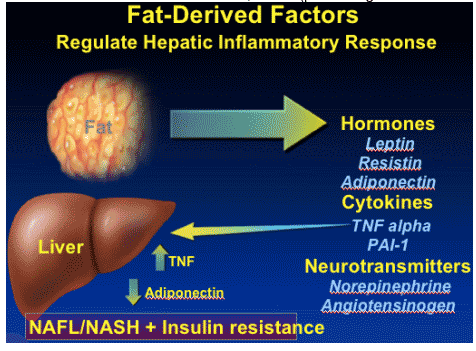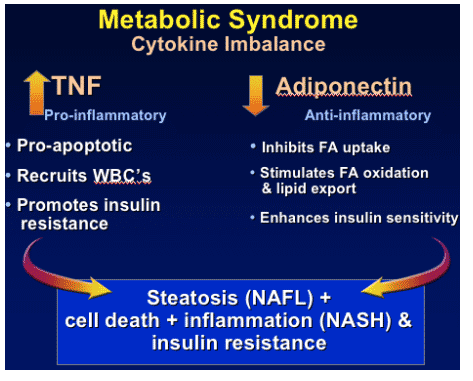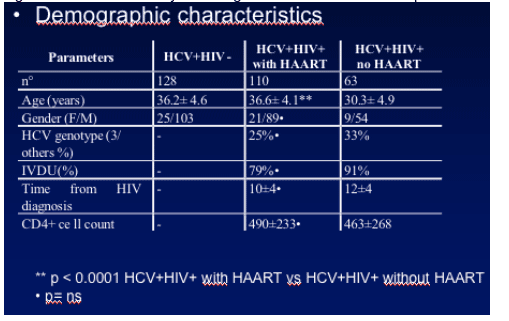 |
 |
 |
| |
HIV May Cause Steatosis- 50% rates of steatosis in HIV & HCV
|
| |
| |
Reported by Jules Levin
Raffaele Bruno's study presented at the 2nd Intl Coinfection Workshop (Jan 12-14, 2005, Amsterdam) finds that HIV itself can cause steatosis (fatty liver). This is the first time I know of a study finding steatosis is associated with having HIV. Bruno suggests that TNF-alfa inhibits adiponectin, promoting steatosis, liver cell death, and hepatic insulin resistance. Leading risk factors for steatosis include insulin resistance, diabetes, and elevated lipids. In this study Bruno evaluates the incidence of steatosis in a cohort of 3 groups: hcv monoinfected, HCV/HIV coinfected under treatment with ART, and coinfected not receiving ART.
BACKGROUND from Bruno (IRCCS San Matteo Hospital, University of Pavia)
Steatosis is an arising problem in the setting of coinfection. HCV/HIV coinfected patients are at greater risk of developing steatosis, but its exact incidence and significance remains unclear.
Steatosis was observed in up to 40% of HIV-HCV-coinfected patients with extensive ART exposure and was associated with more severe HCV-related liver disease. (Sulkowski M. S. AIDS 2005, 19:585-592).
Beyond drug use and genotype 3, one factor that may play a role in the development of steatosis may be the unbalance of inflammatory cytokine network which has been observed in HIV infection.
Both treated and untreated HIV patients showed increased of TNF_ levels and other pro-inflammatory cytokines. (Rizzardi GP et al AIDS 1996; 10:F45-F50
Clerici M. et al AIDS. 2000 Jan 28;14(2):109-16).
AUTHOR CONCLUSIONS
Our data suggest that steatosis was a common finding among coinfected patients, also if they don't take ARVs.
Genotype 3 is an independent predictor of steatosis among all groups of patients
Chronic viral infection (HIV and HCV) may trigger the steatosis process by the release of proinflammatory cytokines (TNF-_).
The relationship between HIV drugs and steatosis needs to be better established as well as the role of both inflammatory and antiinflammtory factors even in patients not taking ARVs.
"Incidence of steatosis in a cohort of HIV-HCV coinfected patients:
results of a retrospective histologic study"
The deposition and storage of fat in the liver depends also by the action of many factors, such as hormones and cytokines. Paticularly, TNF-alfa can inhibit adiponectin, promoting steatosis, oxidant stress, liver cell death, hepatic inflammation and insulin resistance, PAI-1 (plasminogen activator inhibitor).

The unbalance between pro-inflammatory and anti-inflammatory cytokines trigger a cascade of events leading to fat storage, steatosis, cell death and inflammation.

STUDY AIM
Aim of our study is to evaluate the incidence of steatosis in a cohort of patients with HIV-HCV coinfection compared with that of monoinfected patients.
Patients and methods 1:
In the present retrospective single center study, the liver biopsies of 301 patients were reviewed by a single pathologist.
-- 128 HCV monoinfected
-- 63 HIV-HCV coinfected patients never treated with antiretroviral drugs (ARVs) --- 110 HIV-HCV coinfected currently treated with ARVs
Macro - and microvescicular steatosis was quantitatively evaluated. Frequencies were compared by using the _2 test and qualitative data by t-test.
Bruno performed a multivariate analysis, where predictors of steatosis tested in multiple regression analysis were...
Predictors of steatosis tested in multiple regression analysis were:
- Age
- Gender
- Genotype 3 vs others
- Length of HIV infection
- PI use vs non PI use
RESULTS
the characteristics of patients were well balanced among the groups with a significant difference only in the age of treated vs untretaed patients

The percentage of patients with steatosis, defined as moderate/severe, was higher among coinfected patients not receiving antiretroviral drugs (27%) than in those currently on ARVs (12%) and in monoinfected ones (9%) (p = 0.0208, _2 test).
Among HIV patients infection with genotype 3 was significantly related with steatosis (65%vs 44%, p=0,0007).
Prevalence of steatosis
In the table you can see that moderate to severe steatosis is a finding more frequent in patients not treated witn ARVs.

Multiple Regression Analysis

Among factors tested in multivariate analysis, only the presence of genotype 3 was significantly related to the presence of stetaosis. Other predictors were not fitted in the model
|
|
| |
| |
|
 |
 |
|
|